monish
AH elite
John Howard "Pondoro" (Lion) Taylor (1904 - 1969)
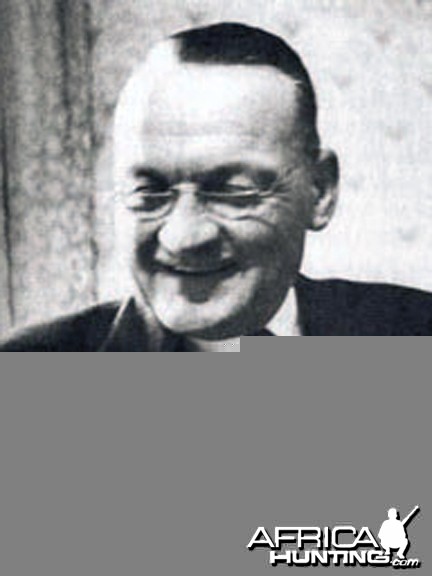
John Howard "Pondoro" Taylor (1904 - 1969), London 1958
He was a big game hunter of Irish descent. Born in Dublin as the son of a surgeon he developed an urge to go to Africa and become a professional hunter. His parents paid for his passage to Cape Town. In Africa he experimented extensively with calibers and different types of rifles which made him an expert in big game rifles. He is credited with developing the Taylor KO Factor, and authored several books. John Taylor died in 1969 in London.
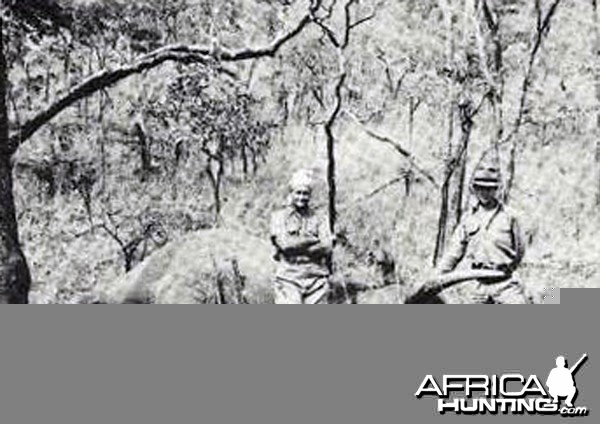
John Taylor and John Dawkins with an Elephant which had been raiding natives' crops.
John Taylor was a professional ivory hunter with some thirty years of continuous living in the African bush. He used and tested all the various calibers of British, American, and German rifles, and with them killed many species of big game found on the continent of Africa. Taylor’s discussion on the practical application of ballistics includes: doubles, magazines, and single-shots; the practical value of steel-jacketed bullets versus those covered with cupronickel; the faults of copper-tubed bullets; the actual effect of soft point bullets with varying degrees of lead exposure; the necessity of modern bullets that will really stand up to the requirements when fired into heavy animals; as well as many other valuable tips and explanations about cartridges.
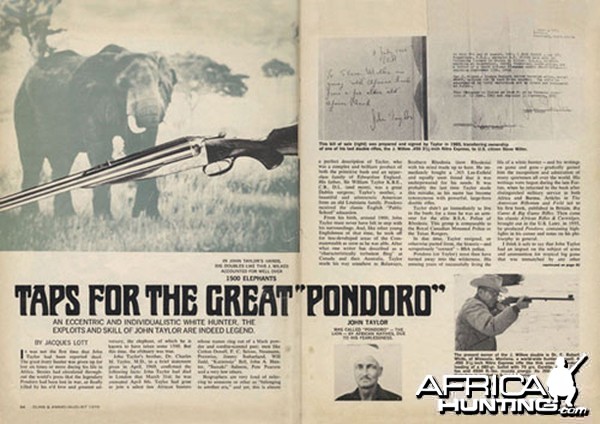
Article on the sale of John Taylor's last double, a John Wilkes .450 3½ inch.
Although Taylor used various firearms for his work as a PH, he preferred the expensive, British double rifles over anything else, especially when tackling dangerous game. His fondness for such cartridges as the 450/.400 Nitro-Express, 500/.465 Nitro-Express and .375 Holland & Holland Magnum are expressed again and again in his writing. His preferred rifle was John Wilkes .450/400 3 & a half inch chambered for which he said , "It has ever been one of my favorites. I have used it extensively on all kinds of African game from elephant down with the greatest possible satisfaction." Speaking of the .375 Magnum (a cartridge still chambered in today's rifles) he writes, "Undoubtedly one of the deadliest weapons in existence. I've had five of these rifles—two doubles and three magazines and have fired more than 5,000 rounds of .375 Magnum ammunition at game. One of them accounted for more than 100 elephant and some 411 buffalo, besides rhino, lions and lesser game. Having hunted over thirty years on the African continent, Taylor is credited with over 1,000 elephant to his bag. Admittedly, a great many of these were not taken under license.

John Howard "Pondoro" (LION) Taylor (1904 - 1969)
Taylor KO Factor (TKO)
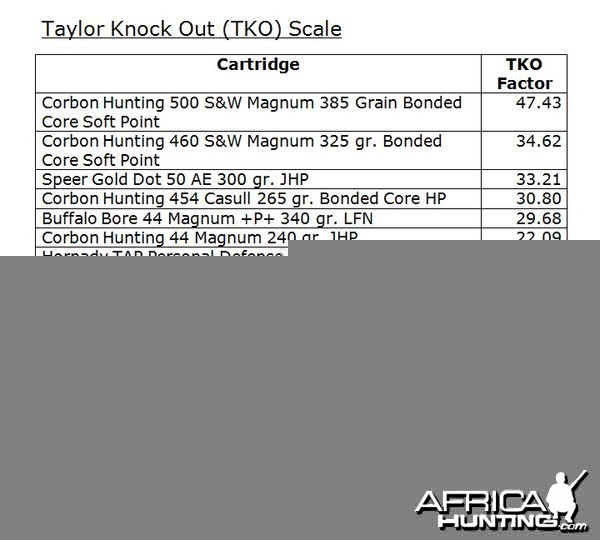
Taylor Knock Out Scale (TKO)
While pursuing his legendary hunting activities, Taylor observed that some cartridges were more effective at stopping elephants than others. He drew a clear distinction between stopping power and killing ability. Since he was always aiming for a brain shot, a properly placed shot with any of the cartridges he evaluated would kill an elephant. He was more concerned with the case where the shot missed the brain and the wounded elephant could turn and attack him. He wanted a cartridge that would "knock out" an elephant even when the bullet struck in a location that was not immediately lethal. To Taylor, a "knock out" simply meant that the elephant was sufficiently stunned by the hit that he would not immediately turn on the hunter. This would allow the hunter sufficient time for an accurate follow-up shot.
Discussions of numerical methods for evaluating cartridge effectiveness has a long history. Many of these methods were popular in the early to mid-20th century. There has been a recent surge in interest in stopping power formulae with the advent of video games. These games use these methods to evaluate the effectiveness of the weapons chosen by the game players. Reference 2 contains a list of the formulae in use by gamers.
Taylor KO Factor is a commonly used mathematical approach for evaluating the stopping power of hunting cartridges. The term "KO" is an ellipsis for "Knock Out." The Taylor KO Factor (TKOF) is a figure of merit that allows hunters to compare bullets with respect to stopping power. The TKOF was developed by John "Pondoro" Taylor. The factor is computed using Equation 1.
:TKOF=frac{m_{Bullet}cdot v_{Bullet}cdot d_{Bullet{7000} (Equation 1)
Where
*m_{Bullet} is the bullet mass in grains (1 pound = 7000 grains)
*v_{Bullet} is the bullet velocity in feet per second
*d_{Bullet} is the bullet diameter in inches
Taylor first described this measure of stopping power in his classic work "African Rifles and Cartridges" (Reference 1). In this work, Taylor did not actually state Equation 1. In fact, he stated in Reference 1 that "I do not think there is any necessity to go into the methods I employed to arrive at the formula I used, suffice it to say that the final figures agree in an altogether remarkable way with the actual performance of the rifles under practical hunting conditions." However, it is obvious from the text and his presentation that he used Equation 1.
Taylor referred to number generated by Equation 1 as the "Knock Out Value" or "Strike Energy." Common practice today is to refer to this value as the "Taylor KO factor" or simply "Taylor KO."
In Equation 1, the denominator value of 7000 is a scaling factor. It can be viewed one of two ways:
* as converting the units of bullet mass from grains to pounds.
* giving the TKOF a convenient numerical value from 0 to ~150 for normal hunting cartridges.
The TKOF has no physical meaning and is strictly used as a figure of merit for comparing cartridges.
Taylor's personal life in later years was one of misfortune. As an alleged homosexual, Taylor was persecuted in Africa in his latter years there and was eventually forced by local authorities to leave Africa. Taking into account his vast experience as a hunter, as well as his expertise with rifles, Taylor should have had no trouble finding a well paying job as a representative of one of the high end gun makers in London. However, whispers alluding to Taylor's past in Africa followed him to England, and he found little work available. Taylor's last years were spent in poverty, a sad end for such an iconic figure.
Books John Taylor wrote
• Big Game and Big Game Rifles (1948)
• African Rifles and Cartridges (1948)
• Maneaters and Marauders
• Shadows of Shame
• Pondoro: Last of the Ivory Hunters

Big Game and Big Game Rifles by John Taylor "Pondoro". The book on the subject. John Taylor was the last professional ivory hunter in East Africa; he was also a legendary figure in his own time. He probably knew more about ammunition and rifles for African game than any other hunter, and he cites his own experiences in the wilds to defend his arguments about which rifle is the best to use on big game. He covers rifles and calibers for elephant, rhino, hippo, buffalo, and lion. Also covered: safeties; single vs double trigger; double rifles; ballistics tables; sights; the .375 H&H; the "all-round" rifle; small-, medium-, and large-bore rifles; and much more. Good stories are included as well as the best advice available.
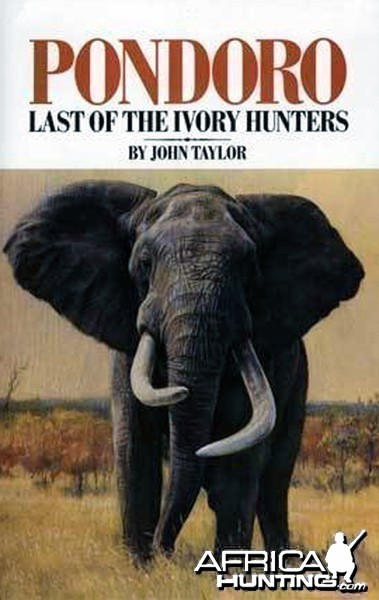
Pondoro, Last of The Ivory Hunters by John Taylor. Pondoro means lion in Chinyungwe. It was the name the natives gave to John Taylor when he first began to hunt in Africa on the lower Zambezi in the early part of the twentieth century. For more than thirty-five years, Taylor was a professional hunter, often out of touch with civilization for as long as three and four years at a time: Taylor said that he did not learn of WWII until some of his men brought back provisions wrapped in old newspapers only then did he learn of the rest of the world wracked by war! Find out what Taylor had to say about the most dangerous animal, how to get downwind of your elephant, what makes a man-eater and how to track it, how hippos navigate in water, when poisonous snakes attack, where to aim when an animal is charging you, and why zebras are considered bad-mannered creatures. Taylor is considered one of the best storytellers in the hunting book world, and Pondoro is highly entertaining.
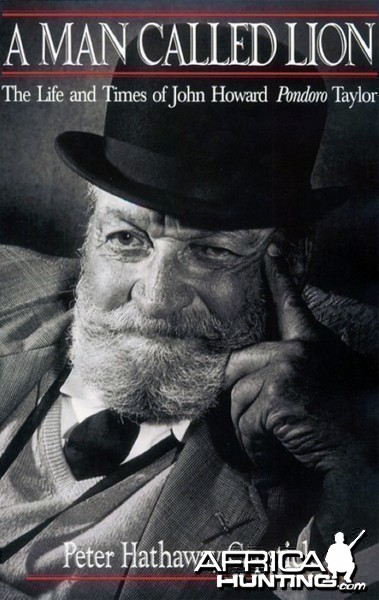
A Man Called Lion, The Life and Times of John Howard Pondoro Taylor. This is the story of one of Africa's most intriguing characters, John Taylor. Taylor was well known for his incredible knowledge of large-caliber African ammunition and rifles, and his entire story is told in fascinating detail. A black sheep born into a wealthy Irish family, he ended up one of the most notorious South African ivory poachers. This book is a culmination of over ten years of research into the life of this mysterious man.
John Taylor is well known to just about anybody interested in firearms or African hunting. This is the first complete biography of this very controversial character, written by Peter H. Capstick with research by Brian Marsh, an old Taylor acquaintance. Capstick tracks the life of this enigmatic figure from his early days in Ireland to the day he left Nyasaland in disgrace and in fear of arrest some forty years later. Also included are his wretched, depressing final years in London. Nothing is held back-whether it be his smuggling affair in Canada, ivory poaching, refusal to pay his bills, his tall tales and impressive escapes, or his homosexuality. This is Capstick at his very best on one of Africa's most intriguing characters.
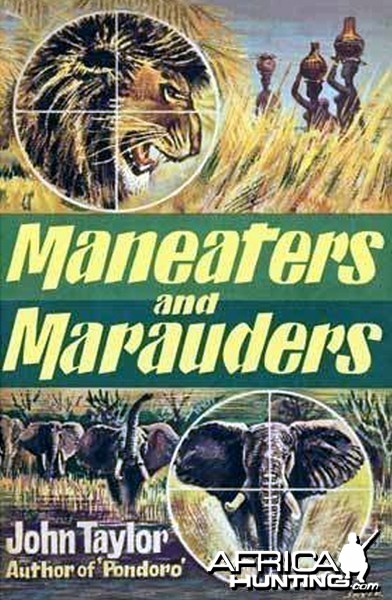
Maneaters and Marauders by John "Pondoro" Taylor. In Maneaters and Marauders, Taylor describes his adventures when hunting down man-eaters and marauders, whether they be lions, crocodiles, or elephants. This is, possibly, John Taylor's most interesting book, for it contains the cumulation of all the dangerous big game Taylor met during his thirty-five years as an ivory hunter. During that time, while living in Nyasaland and Mozambique, Taylor quite often received an SOS from the natives to cull a man-eating cat or a rogue pachyderm. In one instance Taylor dispatched, in the time span of a few weeks, a pride of eleven lions that had terrorized an entire district. Some of these man-eating lions were so frightful that the natives gave them specific names, such as the Benga Man-eaters, the Maiembi Man-eaters, and the Nsungu Man-eaters. As Taylor himself noted, "Those who have not lived among the natives of East and Southern Africa can have no conception of how numerous man-eating lions are in some areas." As if the man-eating cats were not bad enough, there are also stories of bad-actor buffaloes and elephants that raided native crops or trampled a hapless individual or two. John "Pondoro" Taylor was a born raconteur, and the colorful descriptions of his hunts will bring you face to face with some of the most ferocious killers of the African bush.
Monish
John Howard "Pondoro" Taylor (1904 - 1969), London 1958
He was a big game hunter of Irish descent. Born in Dublin as the son of a surgeon he developed an urge to go to Africa and become a professional hunter. His parents paid for his passage to Cape Town. In Africa he experimented extensively with calibers and different types of rifles which made him an expert in big game rifles. He is credited with developing the Taylor KO Factor, and authored several books. John Taylor died in 1969 in London.
John Taylor and John Dawkins with an Elephant which had been raiding natives' crops.
John Taylor was a professional ivory hunter with some thirty years of continuous living in the African bush. He used and tested all the various calibers of British, American, and German rifles, and with them killed many species of big game found on the continent of Africa. Taylor’s discussion on the practical application of ballistics includes: doubles, magazines, and single-shots; the practical value of steel-jacketed bullets versus those covered with cupronickel; the faults of copper-tubed bullets; the actual effect of soft point bullets with varying degrees of lead exposure; the necessity of modern bullets that will really stand up to the requirements when fired into heavy animals; as well as many other valuable tips and explanations about cartridges.
Article on the sale of John Taylor's last double, a John Wilkes .450 3½ inch.
Although Taylor used various firearms for his work as a PH, he preferred the expensive, British double rifles over anything else, especially when tackling dangerous game. His fondness for such cartridges as the 450/.400 Nitro-Express, 500/.465 Nitro-Express and .375 Holland & Holland Magnum are expressed again and again in his writing. His preferred rifle was John Wilkes .450/400 3 & a half inch chambered for which he said , "It has ever been one of my favorites. I have used it extensively on all kinds of African game from elephant down with the greatest possible satisfaction." Speaking of the .375 Magnum (a cartridge still chambered in today's rifles) he writes, "Undoubtedly one of the deadliest weapons in existence. I've had five of these rifles—two doubles and three magazines and have fired more than 5,000 rounds of .375 Magnum ammunition at game. One of them accounted for more than 100 elephant and some 411 buffalo, besides rhino, lions and lesser game. Having hunted over thirty years on the African continent, Taylor is credited with over 1,000 elephant to his bag. Admittedly, a great many of these were not taken under license.
John Howard "Pondoro" (LION) Taylor (1904 - 1969)
Taylor KO Factor (TKO)
Taylor Knock Out Scale (TKO)
While pursuing his legendary hunting activities, Taylor observed that some cartridges were more effective at stopping elephants than others. He drew a clear distinction between stopping power and killing ability. Since he was always aiming for a brain shot, a properly placed shot with any of the cartridges he evaluated would kill an elephant. He was more concerned with the case where the shot missed the brain and the wounded elephant could turn and attack him. He wanted a cartridge that would "knock out" an elephant even when the bullet struck in a location that was not immediately lethal. To Taylor, a "knock out" simply meant that the elephant was sufficiently stunned by the hit that he would not immediately turn on the hunter. This would allow the hunter sufficient time for an accurate follow-up shot.
Discussions of numerical methods for evaluating cartridge effectiveness has a long history. Many of these methods were popular in the early to mid-20th century. There has been a recent surge in interest in stopping power formulae with the advent of video games. These games use these methods to evaluate the effectiveness of the weapons chosen by the game players. Reference 2 contains a list of the formulae in use by gamers.
Taylor KO Factor is a commonly used mathematical approach for evaluating the stopping power of hunting cartridges. The term "KO" is an ellipsis for "Knock Out." The Taylor KO Factor (TKOF) is a figure of merit that allows hunters to compare bullets with respect to stopping power. The TKOF was developed by John "Pondoro" Taylor. The factor is computed using Equation 1.
:TKOF=frac{m_{Bullet}cdot v_{Bullet}cdot d_{Bullet{7000} (Equation 1)
Where
*m_{Bullet} is the bullet mass in grains (1 pound = 7000 grains)
*v_{Bullet} is the bullet velocity in feet per second
*d_{Bullet} is the bullet diameter in inches
Taylor first described this measure of stopping power in his classic work "African Rifles and Cartridges" (Reference 1). In this work, Taylor did not actually state Equation 1. In fact, he stated in Reference 1 that "I do not think there is any necessity to go into the methods I employed to arrive at the formula I used, suffice it to say that the final figures agree in an altogether remarkable way with the actual performance of the rifles under practical hunting conditions." However, it is obvious from the text and his presentation that he used Equation 1.
Taylor referred to number generated by Equation 1 as the "Knock Out Value" or "Strike Energy." Common practice today is to refer to this value as the "Taylor KO factor" or simply "Taylor KO."
In Equation 1, the denominator value of 7000 is a scaling factor. It can be viewed one of two ways:
* as converting the units of bullet mass from grains to pounds.
* giving the TKOF a convenient numerical value from 0 to ~150 for normal hunting cartridges.
The TKOF has no physical meaning and is strictly used as a figure of merit for comparing cartridges.
Taylor's personal life in later years was one of misfortune. As an alleged homosexual, Taylor was persecuted in Africa in his latter years there and was eventually forced by local authorities to leave Africa. Taking into account his vast experience as a hunter, as well as his expertise with rifles, Taylor should have had no trouble finding a well paying job as a representative of one of the high end gun makers in London. However, whispers alluding to Taylor's past in Africa followed him to England, and he found little work available. Taylor's last years were spent in poverty, a sad end for such an iconic figure.
Books John Taylor wrote
• Big Game and Big Game Rifles (1948)
• African Rifles and Cartridges (1948)
• Maneaters and Marauders
• Shadows of Shame
• Pondoro: Last of the Ivory Hunters
Big Game and Big Game Rifles by John Taylor "Pondoro". The book on the subject. John Taylor was the last professional ivory hunter in East Africa; he was also a legendary figure in his own time. He probably knew more about ammunition and rifles for African game than any other hunter, and he cites his own experiences in the wilds to defend his arguments about which rifle is the best to use on big game. He covers rifles and calibers for elephant, rhino, hippo, buffalo, and lion. Also covered: safeties; single vs double trigger; double rifles; ballistics tables; sights; the .375 H&H; the "all-round" rifle; small-, medium-, and large-bore rifles; and much more. Good stories are included as well as the best advice available.
Pondoro, Last of The Ivory Hunters by John Taylor. Pondoro means lion in Chinyungwe. It was the name the natives gave to John Taylor when he first began to hunt in Africa on the lower Zambezi in the early part of the twentieth century. For more than thirty-five years, Taylor was a professional hunter, often out of touch with civilization for as long as three and four years at a time: Taylor said that he did not learn of WWII until some of his men brought back provisions wrapped in old newspapers only then did he learn of the rest of the world wracked by war! Find out what Taylor had to say about the most dangerous animal, how to get downwind of your elephant, what makes a man-eater and how to track it, how hippos navigate in water, when poisonous snakes attack, where to aim when an animal is charging you, and why zebras are considered bad-mannered creatures. Taylor is considered one of the best storytellers in the hunting book world, and Pondoro is highly entertaining.
A Man Called Lion, The Life and Times of John Howard Pondoro Taylor. This is the story of one of Africa's most intriguing characters, John Taylor. Taylor was well known for his incredible knowledge of large-caliber African ammunition and rifles, and his entire story is told in fascinating detail. A black sheep born into a wealthy Irish family, he ended up one of the most notorious South African ivory poachers. This book is a culmination of over ten years of research into the life of this mysterious man.
John Taylor is well known to just about anybody interested in firearms or African hunting. This is the first complete biography of this very controversial character, written by Peter H. Capstick with research by Brian Marsh, an old Taylor acquaintance. Capstick tracks the life of this enigmatic figure from his early days in Ireland to the day he left Nyasaland in disgrace and in fear of arrest some forty years later. Also included are his wretched, depressing final years in London. Nothing is held back-whether it be his smuggling affair in Canada, ivory poaching, refusal to pay his bills, his tall tales and impressive escapes, or his homosexuality. This is Capstick at his very best on one of Africa's most intriguing characters.
Maneaters and Marauders by John "Pondoro" Taylor. In Maneaters and Marauders, Taylor describes his adventures when hunting down man-eaters and marauders, whether they be lions, crocodiles, or elephants. This is, possibly, John Taylor's most interesting book, for it contains the cumulation of all the dangerous big game Taylor met during his thirty-five years as an ivory hunter. During that time, while living in Nyasaland and Mozambique, Taylor quite often received an SOS from the natives to cull a man-eating cat or a rogue pachyderm. In one instance Taylor dispatched, in the time span of a few weeks, a pride of eleven lions that had terrorized an entire district. Some of these man-eating lions were so frightful that the natives gave them specific names, such as the Benga Man-eaters, the Maiembi Man-eaters, and the Nsungu Man-eaters. As Taylor himself noted, "Those who have not lived among the natives of East and Southern Africa can have no conception of how numerous man-eating lions are in some areas." As if the man-eating cats were not bad enough, there are also stories of bad-actor buffaloes and elephants that raided native crops or trampled a hapless individual or two. John "Pondoro" Taylor was a born raconteur, and the colorful descriptions of his hunts will bring you face to face with some of the most ferocious killers of the African bush.
Monish
Last edited by a moderator:
